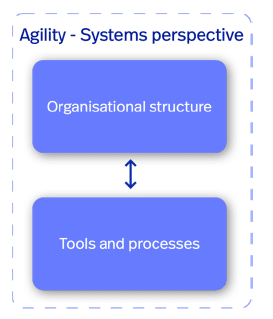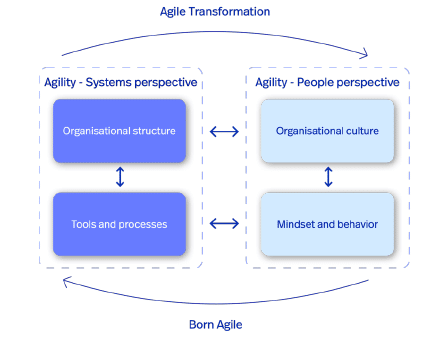- and 5 recommendations to avoid the worst pitfalls
Agility is often described as an organizational utopia - the solution to all competitive problems and a way to fight against the ever-lurking danger of disruption, which has now become a constant concern for all executives when designing their organizational strategies.
There should also be no doubt that implementing agile methods, if done right, can create significant value for the organization. Research from Accenture Strategy shows that agile organizations have an average of 16% long-term EBITDA1 growth compared to only 6% for non-agile organizations. Additionally, research from McKinsey shows that successful agile transformations can end up increasing financial and operational performance by 30% and 50% respectively.
The potential of such prospects puts stars in the eyes of most senior executives, and many organizations are currently working on agile transformations - ranging from small scrum teams in the IT department to large-scale agile transformations. The purpose of this article is to take a closer look at the pervasive agile transformations, as a common denominator for many of these initiatives is that they lose their momentum and fail to build what is otherwise the primary goal of agility - the ability to adapt quickly to changes in the market.
What exactly is agility?

What many organizations forget is that while both systems and people can (thankfully) change, they can't change at the same pace. It's much easier to learn a new way of working or process than it is to learn to think, feel and act in a completely new way.
In addition, it is also more straightforward and concrete to start the implementation of agility by addressing the 'hard' systemic perspective than it is to address the 'soft' human perspective. In other words, the reason why many agile transformations fail is rooted in the way the transformation is approached from the start.
To give an example of why it is a critical mistake to start with the 'hard' aspects of agility without also addressing the 'soft' aspects, we can look at the difference between organizations that are 'born' agile and organizations that are 'transforming' to agility and use Spotify as a case study.
The article continues in the next section.

Curious for more? Download our agile management e-book
In this e-book, you will learn what characterizes agile leadership, not as a one-sided and simplistic leadership skill, but as the ability to balance your leadership in the context in which you lead, and that this form of leadership is not only relevant in pure agile organizations, but for any leader who must navigate in a world of increasing complexity and uncertainty.
Spotify is the pedestal everyone wants to climb - but only a few make it to the top
Spotify is often honored as one of the most successful cases of organizations that have managed to make agile work at scale, and their structure is often referenced as being among the best-practice setups of agile structures.
But, and this is an important 'but', Spotify had an ace up its sleeve from the start that all agile transformations, regardless of size, can't access: Spotify was "born" agile, and as a result, they haven't had to deal with what we might call 'cultural debt'; the deeply rooted, embedded and common perceptions and beliefs about how the organization operated before the agile transformation started.
Spotify and other born agile organizations are created, built and raised with an agile culture, mindset and behaviors as a foundation on which agile tools, processes and structures are incorporated. In comparison, organizations embarking on an agile transformation cannot escape their cultural debt, and therein lies one of the main reasons why agile transformation processes fail.

At its core, it's a classic change management problem. When you embark on a sweeping agile transformation, it's not just a matter of dusting off and tweaking at the edges of the organization. Rather, it's a matter of getting the entire organization and all leaders and employees to rethink more than 100 years of classic, hierarchical management practices.
While it may seem like a tall order, it's not impossible to overcome your cultural debt and make agility take root and anchor itself in the organization, but it requires thinking through the entire transformation process from both the systemic and human perspective from the start, and making sure to develop these in parallel to ensure long-term organizational anchoring.
Five ways to work with cultural debt to ensure long-term organizational adoption of agile mindset and behavior
Recognize that changes in culture, mindset and behavior take longer than changes to organizational processes and structures.
Give attention and support from top management and give HR a strategic role and mandate from the start to support the development of culture and processes in parallel.
Build competency development programs for relevant managers and employees and shape them around specific situations where the new agile cultural values and mindset can create value. This requires a lot of resources and time, but this is also where the critical part of anchoring takes place.
Constantly emphasize why the shift in culture and mindset is an improvement from the 'old normal' and connect improvements directly to business results.
Strengthen organizational buy-in by using change management approaches such as mentoring programs, peer learning, feedback processes and/or shadow coaching. The key is to ensure transfer between learning about the new mindset and behavior and putting the new working methods and processes into practice.
Building an agile organization has great potential for value creation, but the path to get there is complex and full of obstacles, and the ability to ensure long-term agility requires conscious and top-down change management. Since classic organizations can't escape their cultural debt, they need to recognize that changes in culture and mindset are the most difficult process in transformation and therefore need to be as high on the agenda as the systemic perspective to ensure that both systems and culture evolve together.
Sign up for our agile management course
2-DAY COURSE IN AGILE LEADERSHIP
Agile leadership is about adapting your leadership and organization to the task at hand. A crucial skill to succeed in your role as a leader today - and in the future.
The agile leader, who is quick and agile in their approach and can lead in constant change, is therefore in high demand.
Leading agile means, among other things, that decision-making power and competence are pushed downwards and outwards in the organization to a much greater extent. Therefore, as a manager, you must be able to lead across organizational forms, and it is important that you can create a team and learning culture with collaboration spaces across organizational boundaries.
This intensive course will equip you to lead in an agile way. We work on how you can use agility in your management, based on your specific management task. You will be trained in a number of essential management tools to strengthen your daily management and learn how to create an agile and learning culture.




